The State of the App: We Test Five Automaker Apps to See If They Make Car Ownership More Convenient
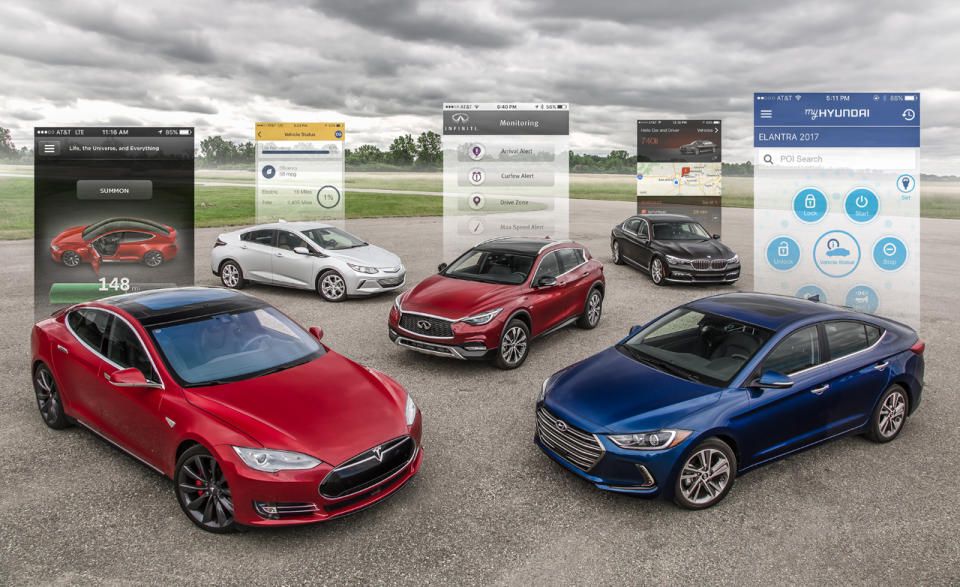
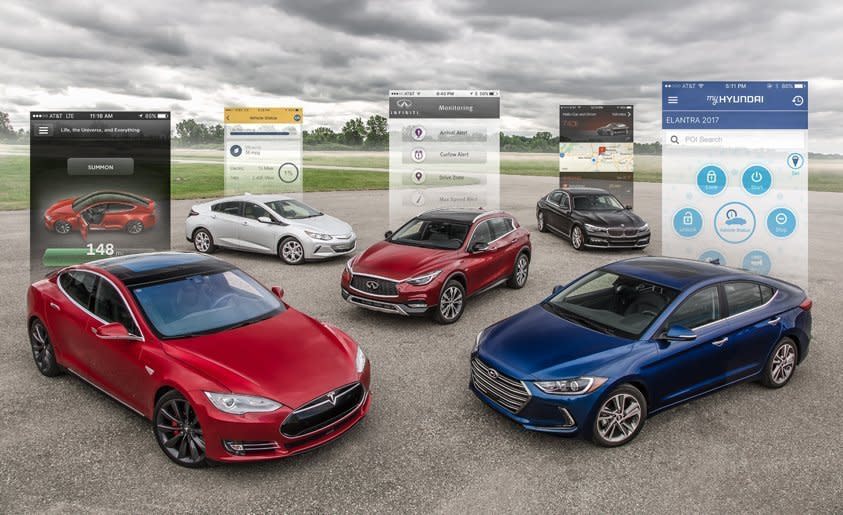
According to the Pew Research Center, 72 percent of American adults own a smartphone as of February 2016—more than double the number reported in 2011. In the past half-decade, smartphones have gone from a toy for the tech-savvy and wealthy to a tool as ubiquitous as the wristwatch (many of which are now “smart” as well).
Automakers are catering to this consumer trend by equipping their vehicles with Wi-Fi hotspots (see General Motors and others), integrating Apple CarPlay and Android Auto functionality into their vehicles’ infotainment systems, and developing their own downloadable apps for smartphones, tablets, and watches. The apps are designed to improve customer convenience, and common features include remote keyless entry, GPS tracking, vehicle diagnostic reports, and the ability to send a destination from your phone to the in-dash navigation system.
We gathered a cross section of five automakers’ mobile apps, as well as compatible vehicles, to examine the breadth and capability of this new technology. These were BMW Connected North America (tested using a 2016 BMW 740i), myChevrolet (2017 Chevrolet Volt), Infiniti Connection (2017 Infiniti QX30), Tesla Motors (2015 Tesla Model S), and MyHyundai, which was previously known as Hyundai Blue Link (2017 Hyundai Elantra Limited). Although we will refer to Hyundai’s app by its current name, note that we completed testing on the previously titled Hyundai Blue Link app and that MyHyundai’s general functions appear essentially the same as those of the Hyundai Blue Link app.
By no means are these five vehicle apps necessarily the best, nor are they the only manufacturer-backed mobile apps available today; however, this quintet of promising options did show off some of the technology’s more useful and/or state-of-the-art functions. Some of the features on these mobile applications are limited to higher-end models. For example, myChevrolet and MyHyundai offer remote-start functionality, something not available on a number of competitors. Meanwhile, Infiniti Connection and MyHyundai were the only two apps we tested that provide real-time speed and location alerts.
In the interest of leveling the playing field, we interacted with the apps on two phones: an Apple iPhone SE 64GB and a Motorola Moto X (second generation). The former represented Apple’s iOS and relied on AT&T as a carrier; the latter ran Google’s Android operating system and used Verizon. On all of our test subjects, save for the BMW Connected North America app, which was unavailable on Android at the time, we used both operating systems to find out if any user-experience or interface differences exist. We can report that operational disparities were few. Any noteworthy variations are mentioned in the text below, which is organized by function.
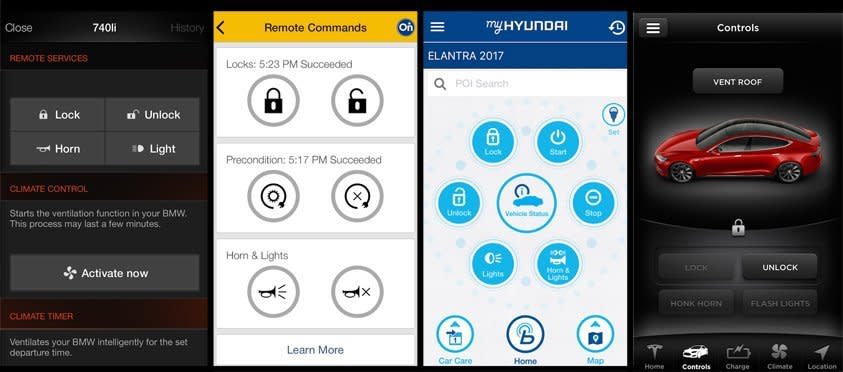
From left to right: BMW Connected North America, myChevrolet, MyHyundai, and Tesla. Infiniti Connection's remote commands are not available on the QX30 due to the vehicle's Mercedes-Benz sourced hardware; however, Infiniti offers this function on its other products.
Remote Locking and Unlocking
With the exception of the Infiniti QX30, every vehicle app we tested included some sort of key-fob functionality. Infiniti doesn’t generally exclude this feature from its Infiniti Connection mobile application. But in the case of the QX30, a vehicle that relies heavily on Mercedes-Benz parts, the Infiniti Connection software is unable to communicate with the Benz-sourced hardware.
The remaining vehicles’ app-based key fobs worked much like a digital version of a standard keyless-entry system: A Lock button locked the doors, and an Unlock button unlocked them. BMW Connected North America recently added unlocking capability, but at the time of our test, only locking could be controlled remotely. In theory, being able to unlock one’s car remotely means that owners can leave their keys behind and still have access to their vehicle. These four apps also offered some form of control of the lights and horn via the digital fob, giving users the opportunity to find their vehicle in a crowded lot.
Each app also had its share of quirks. BMW, Hyundai, and Tesla generally require some form of confirmation before carrying out the commands initiated via the app. In the case of BMW, this means users must hold down the fob “button” on their screen for two seconds before it will allow an action to take place. Hyundai requires users to enter a PIN, and Tesla’s app asks iOS—but not Android—users if they’re sure they want to unlock the vehicle. Some actions through Tesla’s app required entering a password. Meanwhile, myChevrolet consistently completed an action well before the app acknowledged the fact (we know this because we’d hear the car lock or unlock while the app was still registering the request).
For the most part, the apps’ fob functions revealed pleasantly quick response times between requesting an action and seeing the car complete said action. With a response time under three seconds, myChevrolet was the quickest at responding to our appeals on both our iOS and Android devices, and BMW was the slowest at roughly 11 seconds. As a former owner of a General Motors vehicle, this author can attest to the slow response times of the company’s previous OnStar RemoteLink app. Interestingly, General Motors stated that its data does not reveal any difference in response time between the previous app and the current app, but we noticed a significant improvement. Perhaps chalk it up to dynamic factors such as location or carrier.
In short, response times may vary no matter the app and vehicle.
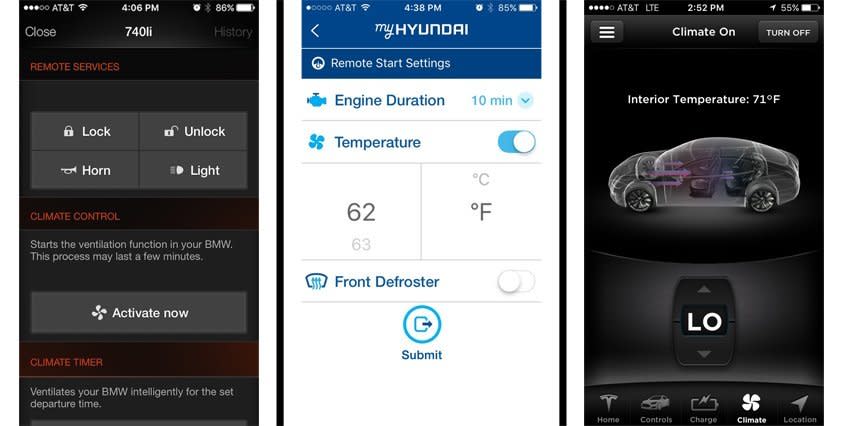
From left to right: BMW Connected North America, MyHyundai, and Tesla all offered some form of remote climate control functionality. Unfortunately, BMW Connected North America limited access to just the fan function, whereas A/C and heating options are offered on MyHyundai and Tesla.
Remote Engine Stop/Start
Of our test subjects, two also offered remote-start functionality. Both our Chevrolet Volt and Hyundai Elantra Limited test cars could be started (and stopped) from the comfort of a couch, courtesy of their respective apps. In the case of myChevrolet, users are given a quick warning on requesting a remote start—but not before a stop—that reminds them: “Use remote start when it is safe and legal.”
Both myChevrolet and MyHyundai require users to input a four-digit PIN before approving remote start and stop, and this command took a bit longer to stream through the airwaves than locking and unlocking, with myChevrolet taking about eight seconds to respond and Hyundai’s app taking almost 30 seconds. Following the press of the app’s Start button, MyHyundai leads users to a page that allows them to set the amount of time the engine will run before shutting off, turn on the front defroster, and adjust interior temperature settings before submitting the request.
The latter feature wasn’t unique to MyHyundai, though. BMW Connected North America also lets users adjust interior climate; however, since the engine can’t be turned on remotely, BMW’s system is only able to operate the fan and not the air conditioning or the heater, making it significantly less useful.
Likewise, Tesla lets its users adjust interior climate settings from the car’s mobile app. HVAC commands were responded to quickly with the Android app, while a loading circle briefly appeared before an action was completed when using iOS.
Although the Tesla Model S doesn’t have a formal remote start or stop function within its mobile app—it doesn’t have an engine, after all—the car’s large-capacity battery pack is always at the ready to devote electrons to completing an app function. Furthermore, Tesla’s app also offers a Keyless Driving function that allows users to drive off without the vehicle’s key. After tapping the Start button located within the app and entering a personal password, the driver has two minutes to enter the car, press the brake, and drive away.
What about Hacking?
As useful as these features can be, there is the real concern of security hacking. A hacker who enters a vehicle app can gain access to the aforementioned remote features as well as the vehicle’s and/or the user’s location information.
“There are a couple of implications here,” Ken Munro, a partner at cybersecurity firm Pen Test Partners, said. “You could find where the vehicle is, and that’s obviously quite useful. Once you’ve gotten in the vehicle, you have access to the wiring [and other systems].”
Pen Test Partners notably discovered vulnerabilities in the Mitsubishi Outlander PHEV’s app, due to what Munro described as the car’s “unusual” method of relying on Wi-Fi instead of a GSM network to communicate information between the car and the mobile app.
GSM networks aren’t invulnerable to hacking, though. Take the Nissan Leaf, a vehicle that uses a GSM network to charter communication between the app and the car, which security researcher Troy Hunt was able to hack.
In the case of the Leaf, its app provided Hunt with information such as the distance traveled during each trip as well as the date and time when each trip occurred. With this information, a hacker could, in theory, figure out an owner’s daily patterns: morning departure time, commute length, what time he or she returns home, and when the vehicle is likely to be left unattended.
“If you have physical access [to the vehicle’s systems] and you can rewrite software, then you have a problem,” Hunt warned. “[A hacker] can actually remain [digitally] present in the vehicle, waiting to strike.”
The automotive industry is now taking steps to avoid future issues related to hacking. Last year, a number of automakers came together to create an Information Sharing and Analysis Center (Auto-ISAC) to share and track threats and vulnerabilities to various automotive systems. More recently, Fiat Chrysler Automobiles announced a “bug bounty” program that pays independent researchers as much as $1500 for bringing security flaws to light.
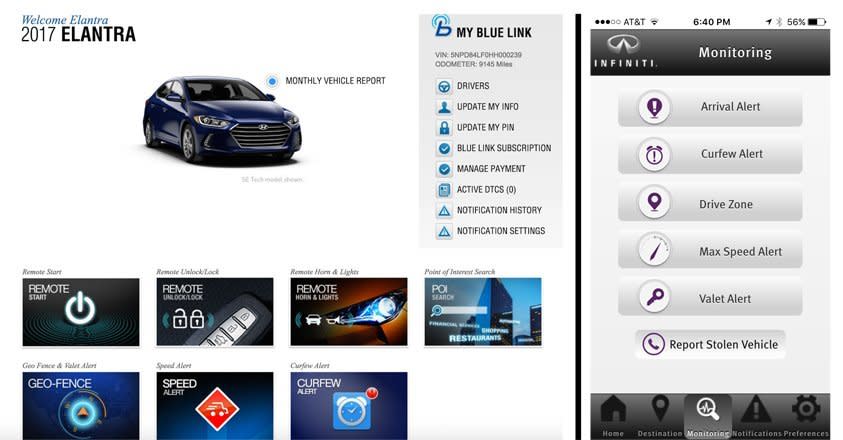
While all alerts on MyHyundai must be set on the MyHyundai website, most alerts for InfinitiConnection can be set within the mobile app itself.
Vehicle Tracking
You don’t need to be an expert hacker, though, to keep tabs on your vehicle. A handful of manufacturers allow app users to set speed and location alerts for their vehicles—a boon for individuals who are prone to using valet parking or lending their car to friends or family. Of the five apps we engaged with, however, only MyHyundai and Infiniti Connection (and only as part of the Infiniti Connection Plus package) offered features of this nature. Unfortunately, we found that both brands have work to do to improve the user experience of these functions.
To use MyHyundai’s alerts, the user must first download a separate app within the vehicle’s infotainment system, something we admittedly struggled to find without the help of a Hyundai specialist. (We found this rather surprising given the generally intuitive nature of the Elantra Limited’s infotainment system.)
Our frustrations were just beginning. We soon learned that alerts can only be set via the MyHyundai website, not from the MyHyundai mobile app itself. Once on the site, users can choose to set alerts for exceeding a specific speed (in 5-mph increments starting as low as 25 mph and as high as 100 mph) or driving during an unapproved time. Furthermore, users can set a location boundary (as little as a mile or as far as 99 miles) around a specific address or point of interest. Users can choose if the boundary is inclusive (meaning alerts are sent if the vehicle leaves the virtual barrier) or exclusive (meaning alerts are sent if the vehicle enters the virtual barrier), and if the boundary is square or circular in shape.
Alerts are sent to the mobile app and are also very briefly displayed on the car’s infotainment screen. We’d prefer if the in-vehicle alerts were displayed longer so that the offending driver has a chance to see when he or she is doing something that goes against the wishes of the vehicle’s owner.
Likewise, Infiniti Connection allows users to set alerts for speed (between 25 mph and 200 mph, as well as specific time frames for when this speed should not be exceeded), curfew, and location boundaries. On top of these features, Infiniti Connection lets a user set alerts for the vehicle’s arrival. As on the Hyundai, in-vehicle alerts are displayed all too quickly on the infotainment screen.
Almost every available Infiniti Connect alert can be set within the app or through the Infiniti InTouch Services web page. The one exception is location boundaries, which can only be set via the web. Once online, users can elect to have the boundary radiate from a selected address by as little as one mile or as far as 3000 miles. Likewise, users can choose whether the boundary is inclusive or exclusive. All alerts in Infiniti Connection are sent to a notifications tab within the app, but users can also choose to have these alerts sent via a phone call, text message, or email.
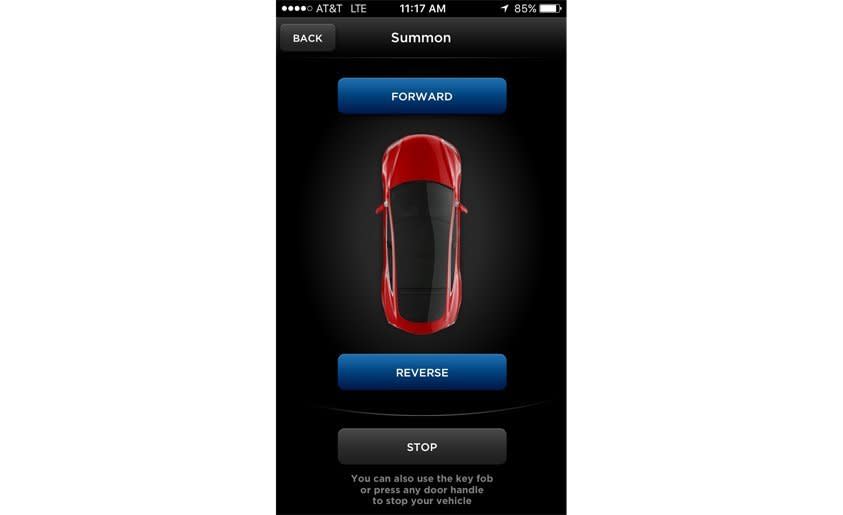
Tesla’s Summon Feature
Given the revolutionary nature of the Tesla Model S, we were surprised to find that the electric vehicle’s mobile app was rather run of the mill. Admittedly, though, it runs the mill like an experienced CEO. Credit the app’s masterful user experience, which makes navigating and using the many available features both easy and logical.
However, Tesla’s app does have a few features that set it apart, such as the ability to let users remotely open or close the car’s sunroof (which we’ve used to torment drivers of our long-term Model S). There’s also the map, which pinpoints not only the car’s location but also the direction in which the vehicle’s pointed. And, of course, there’s Summon, which allows users to remotely drive their Tesla forward or backward. Truth be told, though, unless you actually park your Tesla in a very, very tight parking space (say a narrow garage), the feature is more of a parlor trick. Using Summon is as simple as pushing the app’s Summon button and then using the Forward and Reverse buttons to move the car remotely in said direction. Summon also can be initiated without the app from the Tesla’s touchscreen or with the key fob. We found it generally responsive; however, the car did, rather strangely, turn to the left when we were Summoning it on one occasion (it automatically steers to avoid perceived obstacles, which it must have detected incorrectly).
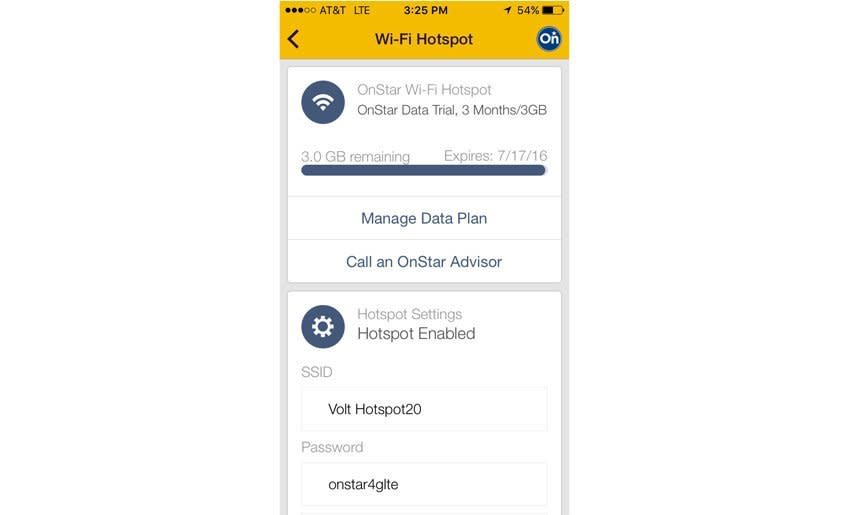
In the Year 2000 . . .
Tesla’s Summon and Hyundai and Infiniti’s alerts weren’t the only futuristic features to be found among the apps we tested. Our 2017 Chevrolet Volt test vehicle, like a number of General Motors products, was 4G LTE enabled and able to serve as a Wi-Fi hotspot. Starting with a free three-month or 3-GB trial, consumers can purchase data plans that range from $10 per month for 1 GB to $40 per month for 10 GB once the trial period is over. Through myChevrolet, owners can manage and keep track of the vehicle’s data, name and enable the hotspot, and set a network password.
Apps and Entrees: The Takeaway
Much like a sunroof or SiriusXM satellite radio, your car or truck’s mobile app is a convenience feature. Treat it as such. If you can afford the space on your mobile device and/or any potential fees to use the app’s features, you’ll likely appreciate what it has to offer. What is certain is that vehicle apps will become very important in the future. In fact, they may even be the primary key fob or become as critical to your car or truck’s performance abilities as the engine under its hood or the infotainment system perched in the center stack. For now, though, communication between one’s car and mobile device is nice—not essential—to have.
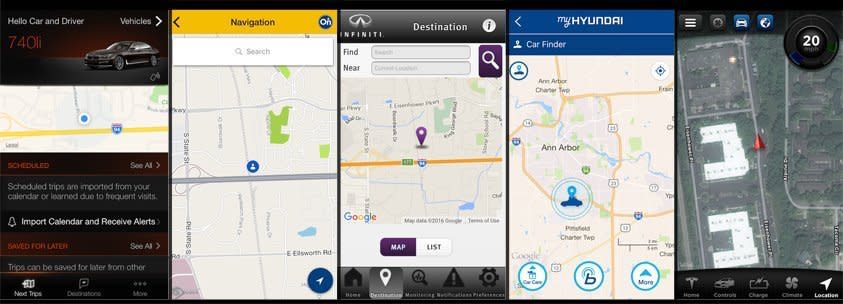
From left to right: BMW Connected North America, myChevrolet, Infiniti Connection, MyHyundai, and Tesla. Only BMW's GPS function is connected to the user's phone and not the car. Tesla's also shows vehicle direction, as well as speed and acceleration inputs if the car is in motion.
The Cost of Convenience
BMW Connected North America (Tested with 2016 BMW 740i)
+/– One of the simpler apps we tested, BMW Connected North America offers interesting features such as the ability to sync your phone’s calendar to the car, send location information from the app to the car, and share information on predicted arrival time via text or email.
Oddities include a remote climate-control function that only works the fan, not the A/C or the heat. Not to mention that, as of now, the U.S. version of the app is limited to iOS. And BMW only recently added lock capability in addition to the ability to unlock from the iOS app.
$ The app, which is free to download, requires that users own a 2014 or newer BMW (excluding the 2014 X6) with navigation and have an active BMW ConnectedDrive/Assist subscription—a service BMW includes on its new vehicles free of charge for four years. After the initial service period ends, consumers must pay for at least one of many individual BMW ConnectedDrive/Assist features to maintain access to the app. ConnectedDrive/Assist subscriptions cost $199 per year for the Safety plan and an additional $199 annually to add the Convenience plan.
myChevrolet (Tested with 2017 Chevrolet Volt)
+/– MyChevrolet offers a boatload of convenience features. The most impressive is its ability to remotely control the vehicle’s 4G LTE Wi-Fi hotspot as well as keep track of data usage.
Special to the Volt are a handful of charging tools. Users can plug in (pun intended) their departure time, plus optimize how the car charges: immediately, based on departure time, or a combination of best rate and departure time.
$ MyChevrolet is free to download; however, to get access to myChevrolet’s more noteworthy features—such as the remote key fob—users must have an active OnStar account. Fortunately, OnStar Basic is included for five years with the purchase of a new General Motors vehicle, after which users will need to purchase an OnStar plan if they’d like continued access to the app’s array of features. Plans currently cost as little as $19.99 per month or $199.90 per year or as much as $34.99 per month or $349.90 per year, depending on the features desired.
MyHyundai (Tested with 2017 Hyundai Elantra Limited)
+/– Like myChevrolet, MyHyundai (formerly Hyundai Blue Link) stood out because of its large list of features. The app offers a fantastic climate-control function via the remote-start system. Users can opt to turn on the front defroster, adjust the interior temperature, and even set the amount of time the engine will idle during a remote start.
Meanwhile, a bevy of alerts that can be pushed to the mobile app can be used to let the vehicle owner know if his or her car or truck is being driven above a specified speed, within a restricted location specified by the owner, and more.
The biggest gripe was that alert settings cannot be made from the mobile app.
$ Blue Link consists of three packages: Connected Care, Remote, and Guidance. Each is available for a limited trial period on MyHyundai–capable vehicles: Connected Car for one year and the other two options for three months. Once the trial is over, the packages cost $99 per year each or $297 per year in total. Connected Care is best described as Hyundai’s take on General Motors’ OnStar, offering convenience features such as automatic collision notification and maintenance alerts. Remote gives app users access to the digital key fob, and Guidance adds Google destination-search functions to the car’s infotainment system. If all you’re looking for is the convenience of a smartphone app, you can download it for free and then plunk down $99 for complete access to the Remote package.
Infiniti Connection (Tested with 2017 Infiniti QX30)
+/– With the exception of the Infiniti QX30, every vehicle app we tested included some sort of key-fob-like functionality. Infiniti, for its part, includes this feature with its Infiniti Connection mobile app, but our test vehicle, the QX30, relies heavily on Mercedes-Benz electronics and other hardware with which the Infiniti Connection software was unable to communicate.
On the plus side, Infiniti makes up for the QX30’s lack of a remote fob by including alerts that rival, if not best, those of MyHyundai. Almost all alerts, save for one, can be requested via the app. Sadly, the app’s user interface is a bit of a mess.
$ Infiniti Connection is free for six months with the purchase of a new Infiniti. To enjoy the alert functions, customers must put down $308 for the Infiniti Connection Plus package after the trial; however, $179 per year gets users a simpler Infiniti Connection package that sacrifices alerts but keeps features such as automatic collision notification, maintenance alert, and alarm notification.
Tesla Motors (Tested with 2015 Tesla Model S)
+/– The king of user-friendliness among the five apps we sampled, Tesla’s app lacks many of the overwrought features that have made the manufacturer’s vehicles so intriguing—except Summon, which allows users to move their Tesla forward or backward using their phone.
Truth be told, unless you actually park your Tesla in a very, very tight space (such as a narrow garage), the feature is more a gimmick than anything else. Using Summon is as simple as pushing the app’s Summon button and then using the Forward and Reverse buttons to move the car remotely in said direction. Summon can also be initiated via the Tesla’s touchscreen or the car’s key fob, requiring no smartphone interaction.
More mundane features that stood out included the ability to open or close the car’s sunroof, as well as the app’s map function, which shows where the car is and its direction of travel.
$ The Tesla Motors app is free to download and use with your Tesla vehicle.

 Yahoo Autos
Yahoo Autos 